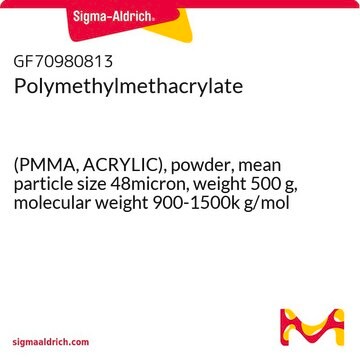445746
Poly(methyl methacrylate)
average Mw ~350,000 by GPC
Sinónimos:
PMMA
About This Item
Productos recomendados
formulario
powder
temp. de autoignición
580 °F
mol peso
average Mw ~350,000 by GPC
viscosidad reducida
150-160 cm3/g(20 °C)(lit.)
número de ácido
<1 mg KOH/g
temperatura de transición
Tg (DSC) 105 °C (midpoint)
solubilidad
alcohols and aliphatic hydrocarbons: insoluble
esters, ketones, aromatics and glycol ethers: soluble
densidad
1.17 g/mL at 25 °C
InChI
1S/C5H9O2/c1-4(2)5(6)7-3/h1-3H3
Clave InChI
PMAMJWJDBDSDHV-UHFFFAOYSA-N
¿Está buscando productos similares? Visita Guía de comparación de productos
Categorías relacionadas
Descripción general
Aplicación
Características y beneficios
Código de clase de almacenamiento
11 - Combustible Solids
Clase de riesgo para el agua (WGK)
nwg
Equipo de protección personal
Eyeshields, Gloves, type N95 (US)
Certificados de análisis (COA)
Busque Certificados de análisis (COA) introduciendo el número de lote del producto. Los números de lote se encuentran en la etiqueta del producto después de las palabras «Lot» o «Batch»
¿Ya tiene este producto?
Encuentre la documentación para los productos que ha comprado recientemente en la Biblioteca de documentos.
Los clientes también vieron
Artículos
Professor Aran discusses engineering graphene-based materials through careful functionalization, enabling diverse applications.
Self-healing soft electronic materials enable autonomous repair, reducing waste and costs in electronic devices.
Fluorescence quenching microscopy visualizes 2D materials like graphene and MoS2 rapidly, inexpensively, and with high fidelity.
Nuestro equipo de científicos tiene experiencia en todas las áreas de investigación: Ciencias de la vida, Ciencia de los materiales, Síntesis química, Cromatografía, Analítica y muchas otras.
Póngase en contacto con el Servicio técnico






